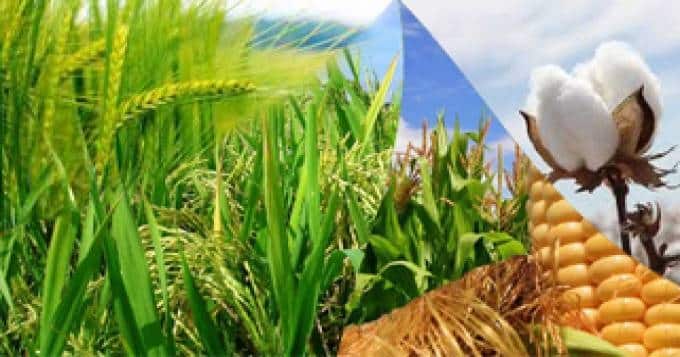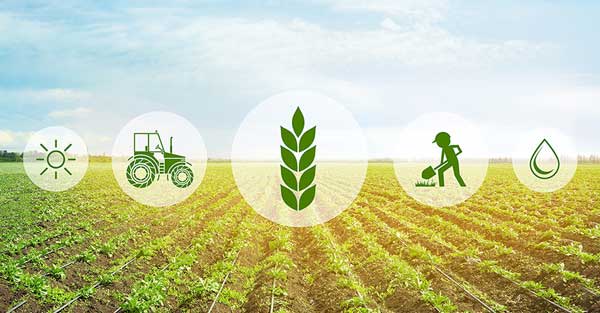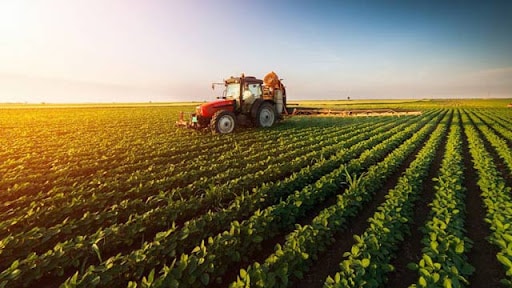Agriculture is important in the economy and is seen as the backbone of the economic system in emerging countries. Agriculture has long been associated with the production of important food crops. Farming in the modern age includes dairy, fruit, forestry, poultry, beekeeping, and various other activities.
In this article, the detail information is put together about the agriculture in Pakistan, the challenges that is faced currently by the department of agriculture of Pakistan and Pakistan agriculture research council. This article widely covers the explanation for the role of agriculture in economic development of Pakistan.
Agriculture of Pakistan
Agriculture contributes 18.5 percent of the country’s GDP in total. 22.1 million hectares of the total land area of 79.6 million hectares.
Agriculture is considered as the foundation of Pakistan’s economy, which would be strongly reliant on its main crops. The primary natural resources of Pakistan are arable land and water. Agriculture contributes around 18.9 percent GDP of Pakistan and employs approximately 42.3 percent of the workforce. Punjab is Pakistan’s most agricultural province, with wheat and cotton being the most.

Widely produced crops. Mango orchards are mainly located in Sindh and Punjab provinces, making Pakistan the world’s fourth largest mango grower.
Agriculture of Pakistan: Major Crops
Wheat, cotton, rice, sugarcane, and maize are Pakistan’s main crops. Together, they contribute for around 63 % of total cropped area. Irrigated regions are used to grow three primary crops: rice, cotton, and sugarcane, but also 90 % of wheat and the majority of maize.
The Agriculture Challenge
Pakistan’s agriculture sector faces numerous issues, including decreasing water resources, a lack of technical development, low-quality seeds, and input supply, amongst many others.
Pakistan’s water resources are its lifeline. The area of irrigated area has increased since the 1950s. Approximately 90% of the water used today is used to irrigate farmland. According to the Pakistan Economic Survey 2016-17, agricultural output accounts for 19.5 percent of the gross domestic product, employing 42.3 percent of the labor force.

According to a 2019 research by the Pakistan Academy of Sciences, Islamabad, the minimum per capita household water demand is 50 litres, whereas 2,600 to 5,300 litres of water is required to grow food for one person per day. As a result, food security is closely connected to water security, as growing food requires 50 to 70 times more water than water utilized for household uses.
However, the “Pakistan Council of Research in Water Resources (PCRWR)” issued a warning in 2016 that the country might run out of water by 2025. According to a 2016 “UNDP (United Nations Development Programme)” assessment, the biggest threat that Pakistan confronts today is not terrorism, but water shortage. According to the “International Monetary Fund (IMF)”, per capita annual water availability in Pakistan has fallen to 1,017 cubic meters from 5300 cubic meters in 1947, approaching the 1,000 cubic meter shortage threshold.
Experts think that providing new solutions to producers and assisting them in attaining successful farming is the best way to deal with the difficulties that today’s agriculture sector faces.
Pakistan agriculture research council
The Pakistan Agricultural Research Council (PARC) (ہیئت برائے زرعی تحقیق پاکستان) is based in Islamabad, Pakistan.
Mission and achievements
It collaborates with the “Ministry of National Food Security and Research”, which is led by a Federal Minister, Syed Fakhar Imam, who has been in charge since April 2020. It is the national top agricultural research institution. Its primary goal is to enhance the agricultural research system of Pakistan, which includes both federal and provincial components.
Pakistan was able to create 20 new high-yielding, disease-resistant, and climate-change-resistant wheat and maize (also known as corn) varieties in 2019. This was accomplished mostly via collaboration between the “International Maize and Wheat Improvement Center” and the PARC. The “United States Agency for International Development (USAID)” also contributed to this initiative.
Recent events
World Food Day was commemorated in October 2019 during an event held at the National Agricultural Research Centre in Islamabad. The United Nations Department of Agriculture, Pakistan’s Ministry of National Food Security and Research, the Pakistan Agricultural Research Council, and the World Food Programme coordinated this event. ‘Our actions are our future: healthful nutrition for a zero-hunger planet,’ was the topic for 2019.
Divisions
“National Agricultural Research Centre (NARC)” at Islamabad, “Southern Zone Agricultural Research Centre (SARC)” at Karachi, “Arid Zone Research Centre (AZRC)” at Quetta, “National Tea Research Institute (NTRI)” at Mansehra, “Sugar Crops Research Institute (SRI)” at Thatta, “Himalayan Agricultural Research Institute (HARI)” at Kaghan, and “Mountain Agricultural Research Center (MARC)” at Juglote sai, Gilgit are the seven primary research divisions in doing research based on the areas’ agro-ecological requirements.
Importance of agriculture in Pakistan

“Agriculture is the process of cultivating land or soil for the goal of producing.” Agriculture is extremely important to Pakistan’s economy and growth. Agriculture directly employs 48 percent of the labor force. As a result, it is the primary source of livelihood or income for the vast majority of the economy’s people. Approximately 70% of the population is directly or indirectly involved in agriculture. Agriculture is the primary source of food for Pakistan’s vast population. Agriculture is also a key supplier of raw materials for Pakistan’s industrial industry. Its contribution to GDP is around 25%, which is greater than any other sector’s contribution.
Crops
Wheat, sugarcane, cotton, and rice are the most significant crops, accounting for more than 75 percent of total agricultural output.
Wheat is Pakistan’s most important food crop. Pakistan’s wheat output in 2018 was 26.3 million tonnes. According to the FAO, Pakistan produced 21,591,400 metric tons of wheat in 2005, more than most of Africa (20,304,585 metric tons) and almost as all of South America (24,557,784 megatonnes). In 2012, the nation harvested between 25 and 23 million tons of wheat.
Pakistan has also drastically reduced the usage of hazardous chemicals.
Except in years when its harvest is badly damaged by droughts, Pakistan is a food supply exporter. Pakistan exports rice, cotton, fish, fruits (particularly oranges and mangoes), and vegetables while importing vegetable oil, wheat, pulses, and consumer goods. The country has the largest camel market in Asia, the 2nd largest apricot and ghee market, and the 3rd largest cotton, onion, and milk market.
Agriculture’s economic importance has fallen since liberation, when it accounted for around 53% of GDP. Following the dismal harvest of 1993, the government implemented farm assistance measures such as higher support prices for various agricultural products and expanded agricultural loan availability. From 1993 to 1997, real agricultural growth averaged 5.7 percent, but has subsequently slowed to around 4 percent. Agriculture changes, such as increased wheat and oilseed output, are key to the government’s budget reform plan.
In Pakistan, outdated irrigation methods have resulted in poor water use. A quarter of the water extracted for agricultural use is wasted due to leaks and line losses in canals. Due to poor soil characteristics and uneven fields, only a small portion of the remaining water is absorbed and utilised by the crops.
A large portion of Pakistan’s agricultural production is used by the country’s expanding processed-food sector. The worth of processed retail food sales increased by 12% per year during the 1990s and was expected to be more than $1 billion in 2000, despite the fact that supermarkets represented for just over 10% of the units.
The Federal Bureau of Statistics tentatively evaluated primary crop yields at Rs.504,868 million in 2005, representing a more than 55 percent increase since 2000, while minor crop yields were assessed at Rs.184,707 million, representing a more than 41 percent increase since 2000. In 2009–10, agricultural exports were Rs 288.18 billion, which included tobacco, vegetables, food grains, fishery fruits products, spices, and animals.
Livestock
The livestock industry accounts for almost half the value gained in the agriculture sector, accounting for nearly 11% of Pakistan’s GDP, which is higher than the crop sector.
According to the main daily newspaper Jang, the national herd includes 24.9 million sheep, 24.2 million cattle, 56.7 million goats, 26.3 million buffaloes, and 0.8 million camels. In addition to this, the country has a thriving poultry industry, with over annual production of 530 million birds. These animals produce 29.472 million tons of milk (which ranks Pakistan fourth in the world), 0.416 million tons of chicken meat, 0.740 million tons of mutton, 1.115 million tons of beef, 8.528 billion eggs, 21.5 thousand tons of hair, 40.2 thousand tons of wool, and 51.2 million skins and hides.
According to the Food and Agriculture Organization, government measures are being done in Pakistan to modernize milk collecting and enhance milk and milk products storage space.
The Federal Bureau of Statistics estimated that this industry was worth Rs.758,470 million in 2005, representing a 70 percent increase since 2000.
Fishery
Fishery play a significant part in Pakistan’s national economy. With a shoreline of around 1046 kilometers, Pakistan has sufficient fisheries resources that have yet to be completely explored. It is also a significant source of export earnings. In Pakistan, fish farming is also a fast-growing sector. The Punjab Province, in particular, has seen tremendous expansion in fish aquaculture. GIFT Tilapia culture has also lately been established in Pakistan, particularly in Punjab province.
Forestry
Forests cover just around 4% of Pakistan’s geographical area. Pakistan’s forests provide a major supply of food, paper, lumber, latex, fuelwood, medicine, and are also utilized for animal protection and tourist.
Role Of Agriculture in Economic Development of Pakistan
Role of Dairy Farming
Dairy production, which is part of the agricultural sector, has also played an important role in economic growth. Livestock or dairy production contributes significantly to economic growth. Annual protein consumption per person is 155 litters of milk and 18 kg of meat. South Asia has the highest rate. Milk, meat, and byproducts have a sizable market. Farmers may earn a decent living by producing and selling these items on the market. This process leads to a rise income in per capita as well as an increase in the economy’s national income.
Role of Textile Industries
Textile industry play a critical role in economic growth. These industries rely entirely on agricultural output in its raw form. Cotton is the most important crop utilized as a raw material in various sectors for manufacture. Furthermore, these items are exported to a variety of economies in return for foreign currency. As a result, cotton as a raw material from the agricultural side helps to the growth in NI (National Income). Textile businesses also generate employment, which raises a person’s per capita income. As a result, we may conclude that the contributions of textile industries to the growth of the economy is significant.
Role of Sugar Industries:
Sugar industrialization is one of the most important areas of the economy in terms of economic development. This is a purely agricultural enterprise. Sugar cane is grown on a massive scale in various parts of Pakistan. This is also supplied to sugar factories for the manufacturing of sugar and other byproducts, both of which have a large market. As large-scale industries, these also contribute to the public’s employment level. This leads to higher values in per capita income as well as an improvement in living conditions.
Rice Export Corporation
Many locations in Pakistan are quite important in terms of rice crop production. The world’s most famous rice crop is grown in various places. A large amount is exported to various economies in return for foreign currency. This international trade is then used to import other items such as new technology or machinery, or it is used to develop the economy’s infrastructure.
Conclusion
Agriculture of Pakistan benefits the nation in 3 categories: higher crop productivity, decreased use of water, fertilizer, and pesticides, which in turn keeps food prices down. Reduced impact on natural ecosystems.
Overall, this article detailed the importance of agriculture, challenges and its solutions, roles of different forms of agriculture that currently are in practice. Pakistan agriculture research council faces challenges in import and exports of different products of agriculture. Where water is the most focused issue, this article provides the details of solution to water issues and other challenges.
At the end, this article explained the valuable roles played by different sectors of agriculture that developed the economy of Pakistan and proved the agriculture of Pakistan as the backbone of the nation’s economy.


